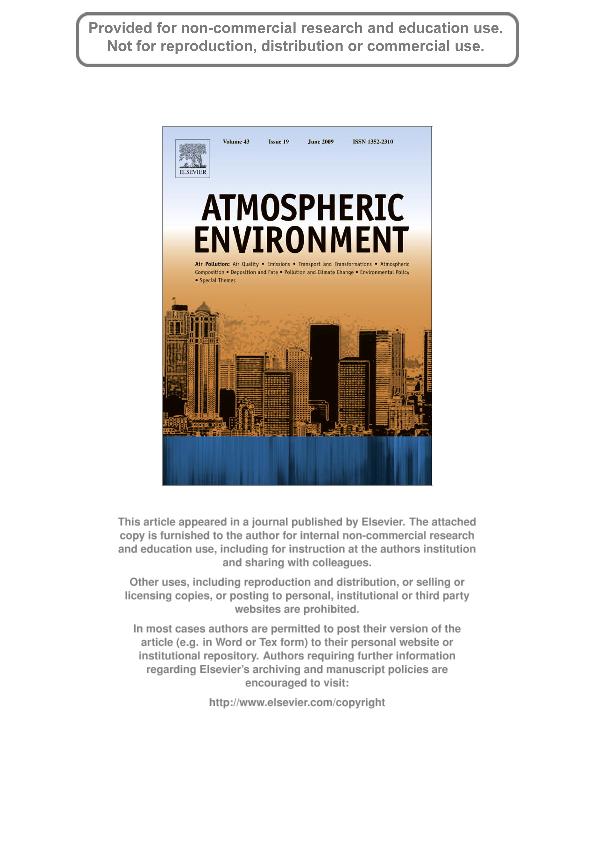Mostrar el registro sencillo del ítem
dc.contributor.author
Lopez, Maria Laura

dc.contributor.author
Palancar, Gustavo Gerardo

dc.contributor.author
Toselli, Beatriz Margarita

dc.date.available
2019-09-03T17:38:52Z
dc.date.issued
2009-06
dc.identifier.citation
Lopez, Maria Laura; Palancar, Gustavo Gerardo; Toselli, Beatriz Margarita; Effect of different types of clouds on surface UV-B and total solar irradiance at southern mid-latitudes: CMF determinations at Córdoba, Argentina; Pergamon-Elsevier Science Ltd; Atmospheric Environment; 43; 19; 6-2009; 3130-3136
dc.identifier.issn
1352-2310
dc.identifier.uri
http://hdl.handle.net/11336/82796
dc.description.abstract
The effect of clouds on total and UV-B irradiance in Córdoba, Argentina, was studied employing the TUV 4.1 model and measurements obtained with YES UVB-1 and YES TSP-700 radiometers, and a spectral radiometer Ocean Optics USB-4000. The experimental measurements were selected from a 10 years dataset (1999-2008). Clouds were classified by direct observation as cirrus, cumulus, and stratocumulus. The broadband Cloud Modification Factors (CMFs) have been calculated in the range of the total and the UV-B radiation for these types of clouds. The relations between them were analyzed for a significant number of days. The broadband CMF values range from around 0.1 up to 1.25, depending on the wavelength interval and on the cloud type. The CMFUVB versus CMFT plots for different clouds have shown good adjustments and significant differences, which allows the distinction between them. Stratocumulus clouds show large attenuations and a linear relation with larger slopes as the solar zenith angle (SZA) increases. For this type of clouds an average slope of (1.0 ± 0.2) was found. The relation between the CMF for cumulus clouds is linear with an average slope of (0.61 ± 0.01). No dependence with the SZA was observed. Cirrus clouds plots show an exponential behavior with fit parameters equal to (0.48 ± 0.08) and (0.68 ± 0.15). However, when small SZA intervals are analyzed a linear relation is found. When the relations between the CMF were similar (cumulus and cirrus), the spectral variation in the UV range (320-420 nm) of a modified CMF (CMFm) was used to distinguish them. Hence, the spectral differences among the three types of clouds have been also analyzed for several days and SZA. Here, it was found that the effect of cirrus is essentially wavelength independent while cumulus and stratocumulus clouds show exponential decay relations but with different ordinates. In the analyzed relations the microphysical properties of the clouds seem to determine its behavior while the optical thickness leads to the different degrees of attenuation. The results obtained in this work are in agreement with those found for other authors.
dc.format
application/pdf
dc.language.iso
eng
dc.publisher
Pergamon-Elsevier Science Ltd

dc.rights
info:eu-repo/semantics/openAccess
dc.rights.uri
https://creativecommons.org/licenses/by-nc-sa/2.5/ar/
dc.subject
Cloud Modification Factor
dc.subject
Clouds Properties
dc.subject
Cordoba
dc.subject
Irradiance Measurements
dc.subject
Radiative Transfer Model
dc.subject.classification
Meteorología y Ciencias Atmosféricas

dc.subject.classification
Ciencias de la Tierra y relacionadas con el Medio Ambiente

dc.subject.classification
CIENCIAS NATURALES Y EXACTAS

dc.title
Effect of different types of clouds on surface UV-B and total solar irradiance at southern mid-latitudes: CMF determinations at Córdoba, Argentina
dc.type
info:eu-repo/semantics/article
dc.type
info:ar-repo/semantics/artículo
dc.type
info:eu-repo/semantics/publishedVersion
dc.date.updated
2019-05-06T14:17:07Z
dc.journal.volume
43
dc.journal.number
19
dc.journal.pagination
3130-3136
dc.journal.pais
Países Bajos

dc.journal.ciudad
Amsterdam
dc.description.fil
Fil: Lopez, Maria Laura. Consejo Nacional de Investigaciones Científicas y Técnicas. Centro Científico Tecnológico Conicet - Córdoba. Instituto de Investigaciones en Físico-química de Córdoba. Universidad Nacional de Córdoba. Facultad de Ciencias Químicas. Instituto de Investigaciones en Físico-química de Córdoba; Argentina. Consejo Nacional de Investigaciones Científicas y Técnicas. Centro Científico Tecnológico Conicet - Córdoba. Instituto de Física Enrique Gaviola. Universidad Nacional de Córdoba. Instituto de Física Enrique Gaviola; Argentina
dc.description.fil
Fil: Palancar, Gustavo Gerardo. Consejo Nacional de Investigaciones Científicas y Técnicas. Centro Científico Tecnológico Conicet - Córdoba. Instituto de Investigaciones en Físico-química de Córdoba. Universidad Nacional de Córdoba. Facultad de Ciencias Químicas. Instituto de Investigaciones en Físico-química de Córdoba; Argentina
dc.description.fil
Fil: Toselli, Beatriz Margarita. Consejo Nacional de Investigaciones Científicas y Técnicas. Centro Científico Tecnológico Conicet - Córdoba. Instituto de Investigaciones en Físico-química de Córdoba. Universidad Nacional de Córdoba. Facultad de Ciencias Químicas. Instituto de Investigaciones en Físico-química de Córdoba; Argentina
dc.journal.title
Atmospheric Environment

dc.relation.alternativeid
info:eu-repo/semantics/altIdentifier/url/https://www.sciencedirect.com/science/article/pii/S1352231009002349
dc.relation.alternativeid
info:eu-repo/semantics/altIdentifier/doi/http://dx.doi.org/10.1016/j.atmosenv.2009.02.065
Archivos asociados
